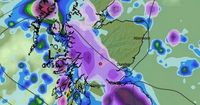As the festive season draws near, the prospect of a white Christmas is capturing imaginations and fueling travel anxieties on both sides of the Atlantic. This year, meteorologists and weather enthusiasts are abuzz with predictions of a dramatic shift in winter weather patterns, raising hopes—and concerns—about snow-dusted celebrations from New England to Wales, and from Scotland down to Gloucestershire.
According to the Old Farmer's Almanac, Christmas week 2025 is shaping up to be a classic winter spectacle for much of New England. The Almanac forecasts “very cold weather and snow showers” across the region, especially in the days surrounding December 25. “Snow is expected across many areas of the United States, including the Northeast, Upper Midwest, Lower Lakes, the eastern Ohio Valley, and Alaska—where scattered snow showers and flurries may make traveling a challenge statewide—leading to a chance for a white Christmas,” the Almanac noted. For those planning to hit the road or take to the skies, the advice is clear: prepare for slippery roads, allow extra travel time, and drive cautiously.
While the bulk of the snow is expected further north, particularly in Maine, the cold blast is set to sweep across the entire Northeast. Those venturing beyond New England for the holidays won’t necessarily escape the wintry weather. The Almanac also points to possible snow in the Upper Midwest, Lower Lakes, eastern Ohio Valley, and Alaska. Meanwhile, the Pacific Northwest is bracing for storms and rain just before Christmas, and the Intermountain and High Plains regions could see a mix of rain and snow. The Pacific Southwest might catch some rain just after Christmas, while the Deep South and Atlantic Corridor are in for a patchwork of rain and sunshine. Even the Appalachian region will experience sunny skies in the north, showers in the south, and a chance of snow creeping in closer to Christmas. The Desert Southwest, on the other hand, will see sun with the occasional isolated shower.
But the story doesn’t end in North America. Across the Atlantic, the UK is facing its own winter intrigue, with meteorologists eyeing the skies for signs of a rare weather phenomenon: Sudden Stratospheric Warming (SSW). As reported by North Wales Live, weather charts suggest the possibility of an SSW event in late November, which could disrupt the Polar Vortex—the atmospheric circulation that typically locks freezing temperatures into polar regions. When this system is disturbed, frigid polar air can surge southward, dramatically increasing the chance of snow and ice across the northern hemisphere.
Severe Weather Europe weighed in, stating, “A significant disruption of the Polar Vortex is about to start, due to an unusually early Sudden Stratospheric Warming event. The forecasts show a collapse of the polar circulation in the second half of the month, with cold weather and snow to follow across the United States and Canada, but with less clear impacts over Europe for now.”
While the Met Office has yet to make an official statement on the SSW projections, they did note, “Sudden Stratospheric Warming does not always result in this outcome—but a cold snap follows more often than not, so these events greatly increase the risk of wintry weather.” If the SSW event unfolds as some meteorologists expect, mid-December could see a significant uptick in wintry conditions across the UK, with Wales and Scotland especially in the firing line for snow.
Indeed, the Met Office has already flagged the week of November 16-21 as a period of heightened risk for sleet, snow, and icy conditions. By Sunday and Monday, November 16 and 17, “there is a reasonable chance of sleet and snow in northern Scotland, with the risk spreading further south into Northern Ireland, northern England, and North Wales by Tuesday,” according to their forecast. Models suggest a 20% or greater chance of more than 1 cm of snow in southern parts of the UK during the middle and end of next week. Alongside snow, the risk of ice is high, particularly where rain falls onto cold surfaces.
Snow maps from WX Charts, as cited by The Daily Record, predict a “wall of snow” set to blanket Scotland early in the week, beginning Tuesday, November 18. West Scotland—including Oban, Fort William, and Lanarkshire—should expect flurries by 6 a.m., with the snowstorm moving east to Perth, Stirling, and Edinburgh by midday. Northern Scotland is likely to see snow flurries by 9 p.m. that evening, which will taper off into smaller clumps by midnight. The snow will persist in spots along the northeast and northwest coasts on November 19, and will return to central Scotland—including Glasgow, Edinburgh, and Dundee—on Friday, November 21.
Temperatures are set to plummet as Arctic air engulfs the UK. As reported by Gloucestershire Live, parts of Scotland could see lows of -4°C during the early hours of Monday, November 17, with the North West of England dipping to -2°C the following night. Central England and Scotland can expect overnight lows between 0-2°C on Wednesday. The Met Office expects that as high pressure moves southward, pulling in icy northerly winds, wintry conditions will spread nationwide—potentially bringing the first snows of winter to more than 20 areas, including Gloucestershire and Wales, by Tuesday, November 18. Northern Ireland could also see a dusting of snow by Wednesday, November 19.
Historically, Wales has experienced 26 white Christmases over the past 62 years, with the last widespread lying snow on Christmas Day occurring in 2010. Mike Kendon, an information scientist at the Met Office’s National Climate Information Centre, explained, “The UK’s mild, maritime winters and influence of the Gulf Stream mean that traditional White Christmases have always been relatively uncommon in our climate, but recent global warming has now made them even less likely than they were a few decades ago. Nevertheless, although increasingly unusual, widespread lying snow does occasionally occur in the UK in winter, and the chance of this coinciding with Christmas cannot be ruled out altogether.”
For travelers in both the US and UK, the convergence of busy holiday schedules and potentially hazardous winter weather means planning ahead is more important than ever. The week of December 25 is traditionally one of the busiest travel periods of the year, and with forecasts pointing to snow, ice, and freezing temperatures, those on the move should build in extra time and stay alert to changing conditions.
As for the calendar, Christmas Day falls on Thursday, December 25, 2025. Hanukkah begins on the evening of Sunday, December 14, and lasts until sundown on Monday, December 22, while Kwanzaa runs from Friday, December 26, to Thursday, January 1, 2026. The Winter Solstice arrives on Sunday, December 21, at 10:03 a.m. ET, marking the official start of winter—and, perhaps, the height of this year’s wintry drama.
With weather models shifting, meteorologists hedging their bets, and travelers bracing for the unknown, one thing is certain: whether you’re hoping for a white Christmas or dreading the travel delays it might bring, December 2025 is shaping up to be a holiday season to remember.





